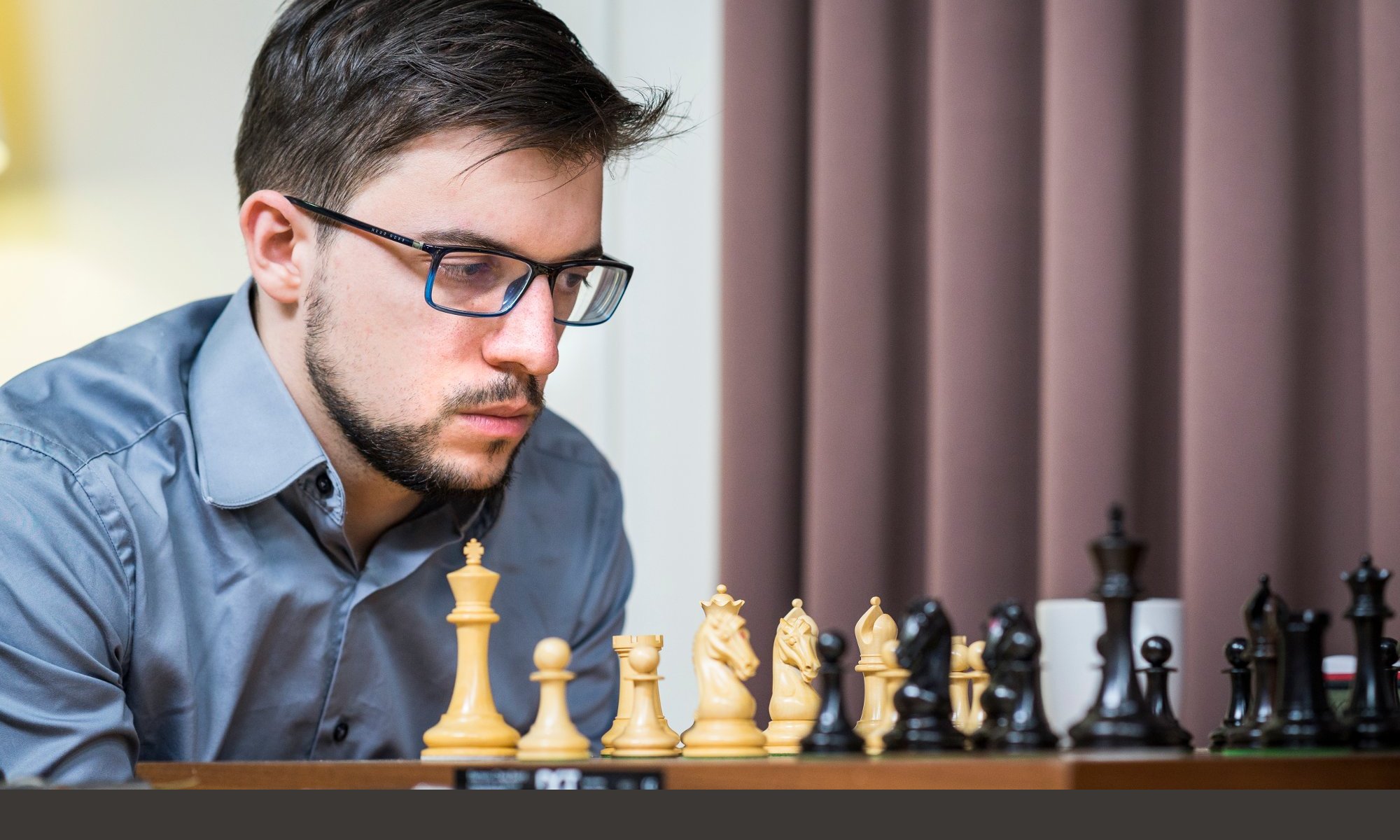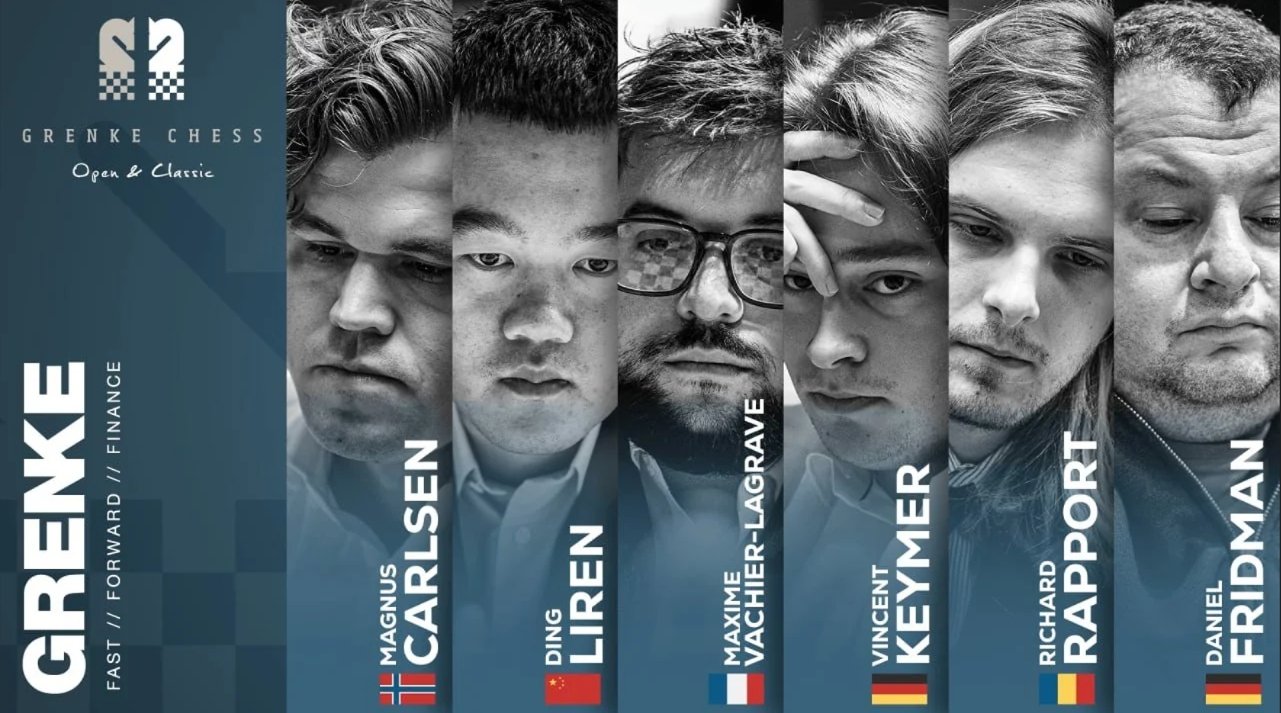A few weeks ago, the sponsor of my German team in Baden-Baden sent me an invitation to a prestigious tournament that I had no reason to decline!
So I arrived in Karlsrühe the day before the tournament straight from Austria, where I’d played the final games of the Austrian Team Championship with my club Linz (4.5/5 for Maxime and a new championship title 😊).
The Grenke tournament was kind of a « revival », as the last edition had taken place in 2019. The 2020 edition was planned but had to be cancelled due to the Covid pandemic. The sponsor also skipped the next three years. However, it was all the better to come back this year, with a festival that will go down in history!
I received my invitation rather late, but for a last-minute event, the organizers really pulled out all the stops, with almost 2800 players in the Opens – a real performance! Of course, the 6 Classic players (Carlsen, Ding, Rapport, Keymer, Fridman and myself) were in great demand for autographs and selfies, especially as there were so many youngsters in the Opens. Magnus’ presence, of course, and that of Ding Liren too, added a lot of cachet to the tournament.
Unsurprisingly, this led to delays in every round. But it was understandable and hardly embarrassing in truth. And this gigantic gathering of chess players created quite an atmosphere around the tournament. It’s impressive to have so many players in one place, and a whole city « breathing chess » for a week. I’m not going to be hypocritical, it’s not necessarily very easy to play in these conditions, because inevitably there’s noise; but that’s the other side of the coin, you can’t have conviviality and monastic silence at the same time 😊.
On a personal note, I had quite a few friends and acquaintances who played in the Opens, which was very pleasant in the sense that it provided a bit of a social link that I’m not used to in top-level tournaments.
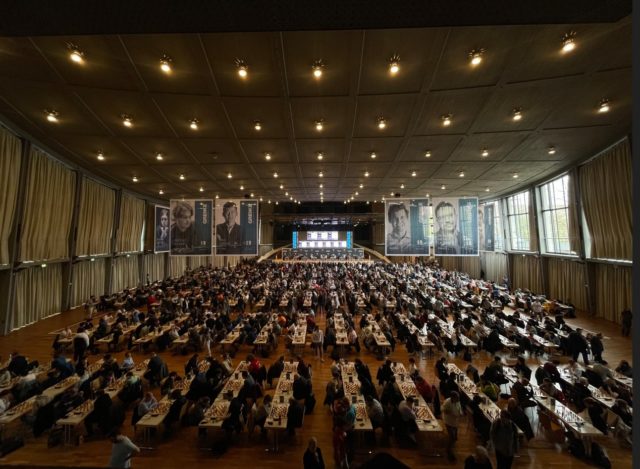
As far as the rhythm of play (45+10) is concerned, this tournament was a kind of test, although some – including myself – had already been able to try it out at the 2022 World Team Championship in Jerusalem. The basic idea is to be able to play two games a day. But the pace is still pretty fast. While I never struggle with the clock in Classical games, here in Karlsrühe I’ve sometimes ended up in zeitnot. All in all, the games were of fairly good quality; except perhaps in the endgames, where it’s often complicated to play precisely, especially at certain critical moments (I’m thinking, for example, of my first game against Magnus, to which I’ll return below).
Personally, I thought it was too bad not to play the double round against the same opponent alternating colors, which would have seemed more logical.
Overall, I’d say that this pace of play is interesting, even if it’s obviously intense, since there’s hardly any break between games. Of course, you can choose to do a light preparation in the morning to compensate, but even so, you’re burning up energy. Another thing I regret a little is that the organizers chose to negotiate a fee with the players (or their representatives), and not to award prizes. No prizes, no points for the Classical rating, there was not much at stake, even if there was obviously still the chance to add a tournament to your track record! But if you don’t win, 3rd or 5th in the tournament is almost the same…
On the final day, mini-matches determined the final places (1 vs 2, 3 vs 4, 5 vs 6). I won my match for third place against Keymer. Of course, I was determined to do well, but in reality, it wasn’t like winning a bronze medal at the Olympic Games 😊.
Here’s a look back at some of my games at the Grenke Classic:
Mvl-Fridman, Round 3 : 0-1
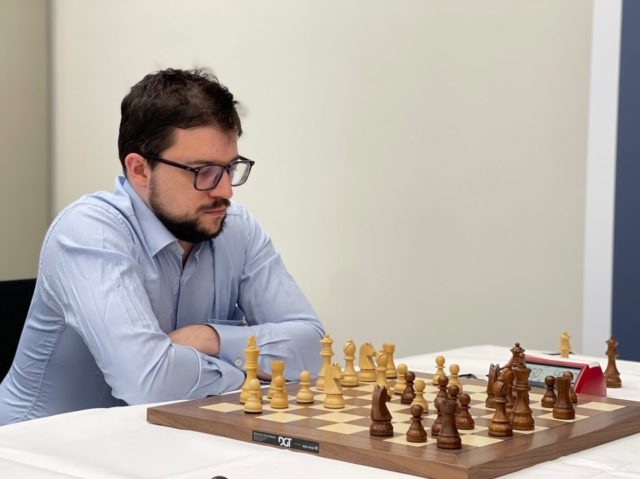
The opening didn’t go very well for me; I wasn’t out of prep, but I didn’t expect him to master this variation of the French defense so well. So I wasn’t sure what I was doing. At one point, however, I decided to vary a little from the usual plans for this type of position, notably when I decided to take back the sacrificed pawn in the opening, which is usually left « for life ».
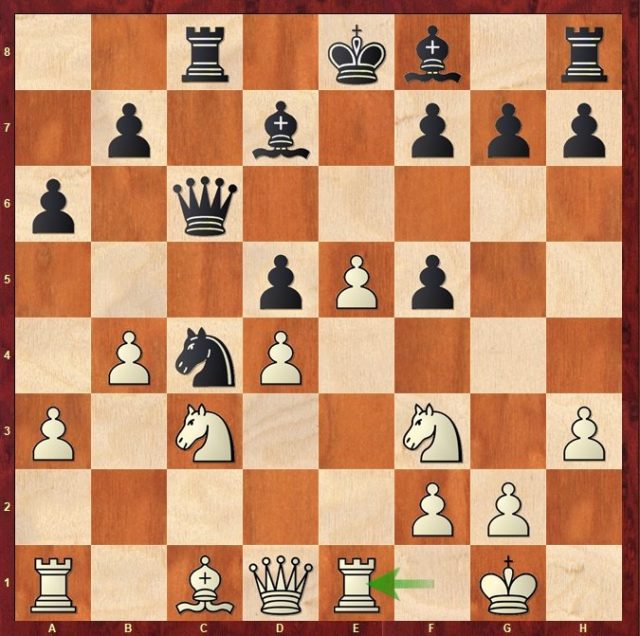
But it wasn’t necessarily a terrible decision, and just afterwards there was the critical moment when he played 16…Be7, a slightly inaccurate move, starting with 16…h6 would have been safer. After 17.Bg5, he could have tried to win the piece with 17…Nb2, but in the end he decided not to because it looked very dangerous after 18.Qe2 Qxc3 19.e6 fxe6 20.Rac1 Qxa3 21.Rxc8+ Bxc8 22.Bxe7 Kxe7 22.Qe5. At least that’s what I’d seen and that’s more or less the computer line; there’s a whole bunch of possibilities and I find it rather frightening for black!
In the end, I gradually took the advantage, but it was never easy, even though I thought it would be in the following position:
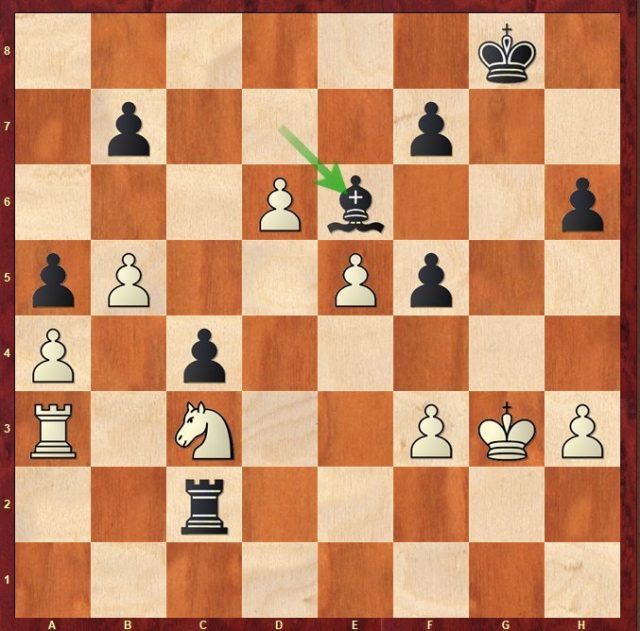
After 40.Nd5! Kf8 (40…Bxd5? 41.d7), my mistake was not to play 40.Nf6!; the King comes to f4, the Rook slides to g1 via a1, and black’s King is in dire staits while the c-pawn will have trouble distracting white. Unfortunately, I thought that with 40.Rc3? Re2 41.Ne3, I’d take the c4-pawn, except that after 41…Ra2, if 42.Nxc4? then 42…f4+! 43.Kxf4 Rxa4 or 43.Kh4 Rh2 and I’d be mated.
After that, I had to change my plans, but the situation spiraled out of control. I probably missed another win, and the endgame was a succession of reciprocal errors played out with little time on the clock, before I went completely off the rails and cracked last…
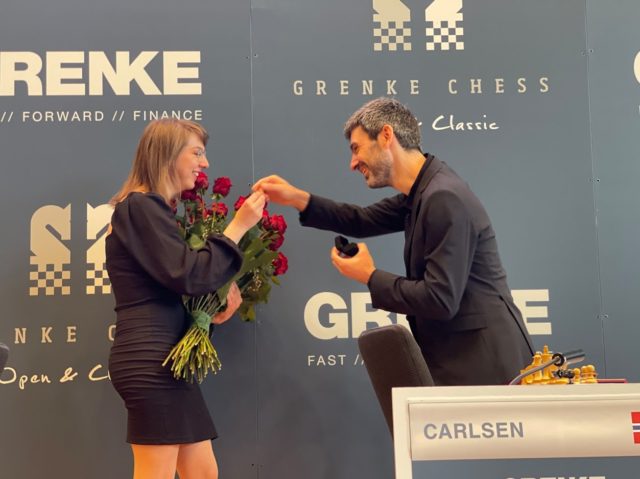
Carlsen-Mvl, Round 4 : ½
Just after this horrible defeat, I followed up with black against Magnus! Admittedly, there’s not much to fear when Magnus plays 1.e4 c5 2.Nf3 d6 3.Nc3 Nf6 4.Be2 e5 5.Bc4 😊. You can feel that you’re not necessarily going to be worse if you know roughly how to react, which I did, with a rather well-controlled opening.
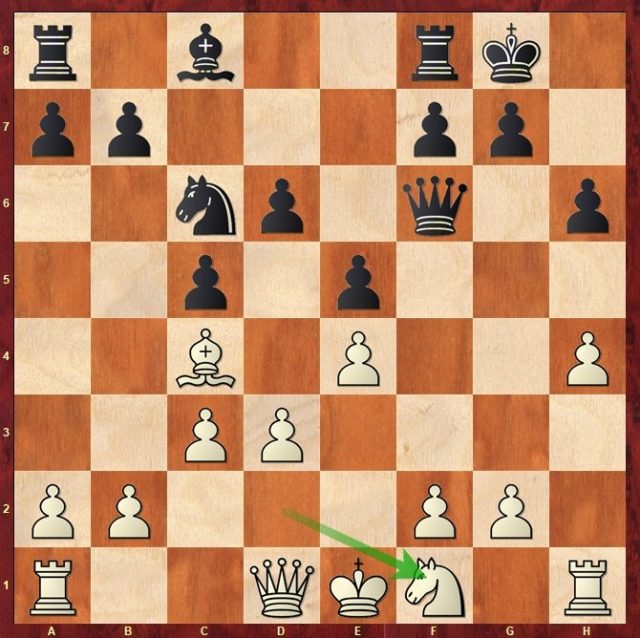
Here, I could have simply played 14…Be6, but in fact I was stuck with the idea that I should try to push …f5 as quickly as possible, so I preferred 14…Kh8 15.Ne3 Qg6. He decided to drastically prevent …f5 and pushed 16.g4, on which I had calculated that I was bringing my Knight to f4 starting with 16…Nd8 but it was actually a bit risky; 17.Df3! was well played, at least from a practical point of view, since if I play 17…Ne6 now, he’ll exchange on e6 and I can’t take back the pawn, ending up really badly off on the Kingside: he’ll simply follow up with Ke2, Rag1 and g5, and I didn’t want to let that happen. So I chose to temporize, even at the cost of opening the g-file with 17…Bd7 18.g5 Ne6 19.gxh6 gxh6. From then on, it became highly complicated, with a three-result position on the board.
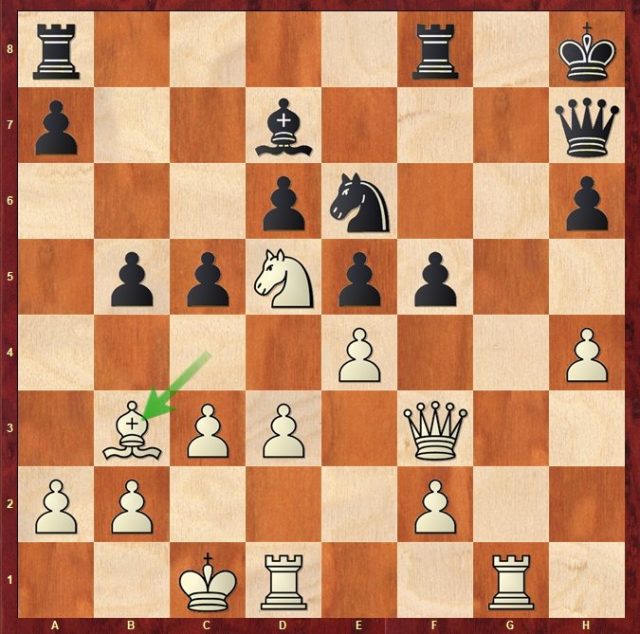
Instead of the normal 23…fxe4, I got a little cocky and started with 23…c4? which is a mistake; I should have felt that with my Queen on h7, I shouldn’t ask too much of the position! Fortunately, Magnus didn’t find 24.dxc4 fxe4 25.Qe3! Rf3 26.Qd2 Nc5 (not necessarily obvious at first, but black’s position is too disharmonious after 26…Rd3 27.Qe1!) 26.Nf4! followed by 27.Qxd6 and black is on the verge of collapse.
In the game, I had seen the position up to 24.Bc2?! fxe4 25.Qxe4 Qxe4 26.dxe4 Be8 27.f4! (otherwise, I attack f2 and threaten …Rd8 followed by …Nf4 at any time). After 27…Bh5 (I spent a lot of time on this move because I thought he might want to play 28.f5 and checked that it was okay for me, which it is after 28…Bxd1 29.Rxd1 Nf4 or 29.fxe6 Bxc2 30.Kxc2 Rf2+ 31.Kc1 Rg8!) 28.Rd2 exf4? (28…Nxf4 29.Nxf4 Rxf4 30.Rxd6 Kh7 =)
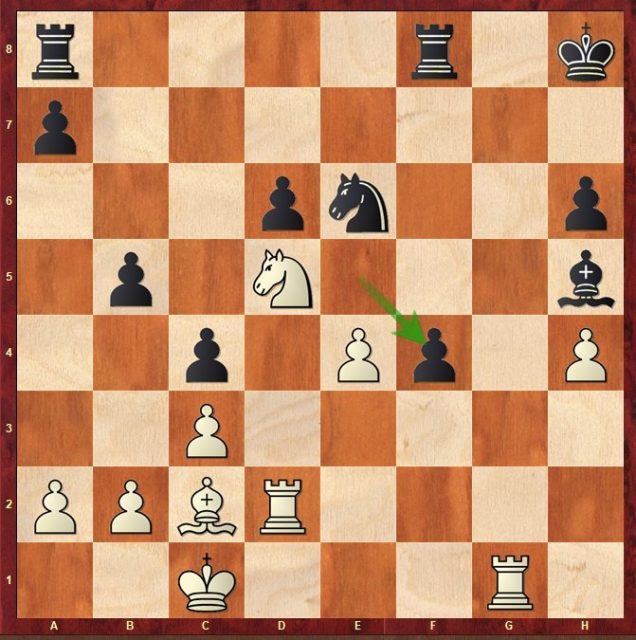
I knew I stopped 29.Ne7 (threatening 30.Ng6+) because of 29…f3, but just as I was taking on f4, I realized I was allowing 29.Nc7!.
What a cold shower! I hesitated to resign at once, but saw that I still had 29…Rg8 (the forced line 29…Nxc7 30.Rxd6 Rf7 [30…Kh7 31.e5+] 31.e5 Rg7 32.Rxh6+ Kg8 33.Rxg7+ Kxg7 34.Rxh5 leaves an easily winning endgame to white) 30.Rxg8+ Kxg8 31.Nxe6 Rg1+ 32.Bd1 Rf1 (but not 32…f3? 33.Rf2) and my f-pawn still leaves me with vague practical chances. And that’s precisely what happened (albeit with a little help😊) 33.Rxd6 f3 34.Nf4
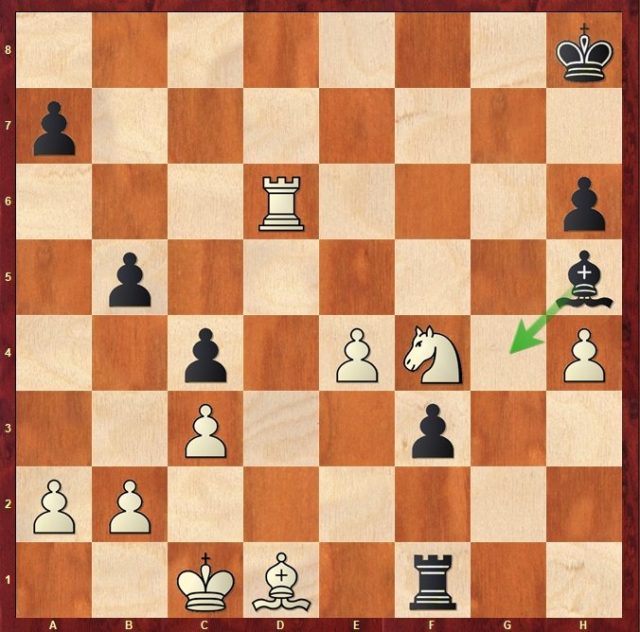
Here, Magnus panicked, and thought for almost his remaining 2 minutes. He believed 34…Bg4 was impossible because of 35.Rxh6+ Kg7 37.Rg6+ Kh7 38.Rxg4, but after 38…f2, none of his pieces can sacrifice themselves on the f-pawn, which queens; the position still remains a draw after 38.Nd5 Rxd1+ 39.Kxd1 f1=Q+ 40.Kc2, thanks to the check on f6. Looking for the win and not finding it, he relied on 35.Ng6+? which happens not to be enough. Yet he had two ways to win. The radical 35.Nh5! f2 (35…Bxh5 36.Rxh6+ Kg7 37.Rxh5 f2 38.Rf5 +-) 36.Rd8+ Kh7 37.Nf6+ and 38.Nxg4. The other, slower way, was to start with 35.Kc2 before giving the check on g6. If 35…f2, now 36.Ng6+ Kg7 37.Bxg4 Rc1+ 38.Kxc1 f1=Q+ 39.Rd1 followed by 40.Bf5!, everything is protected and white will win.
In the game, Magnus was forced to give the piece back and settle for an even Rook endgame after 35…Kg7 36.Kc2 h5 37.Ne5 f2 38.Rg6+ Kh7 39.Rf6 Bxd1+ 40.Kd2 Bg4 41.Ke3 Re1+ 42.Kxf2 Rxe4 43.Nxg4 Rxg4.
Even so, I could very well have lost this endgame, because I made it difficult for myself by not activating my King when it was possible. Even at the very end, he could still cause me problems…
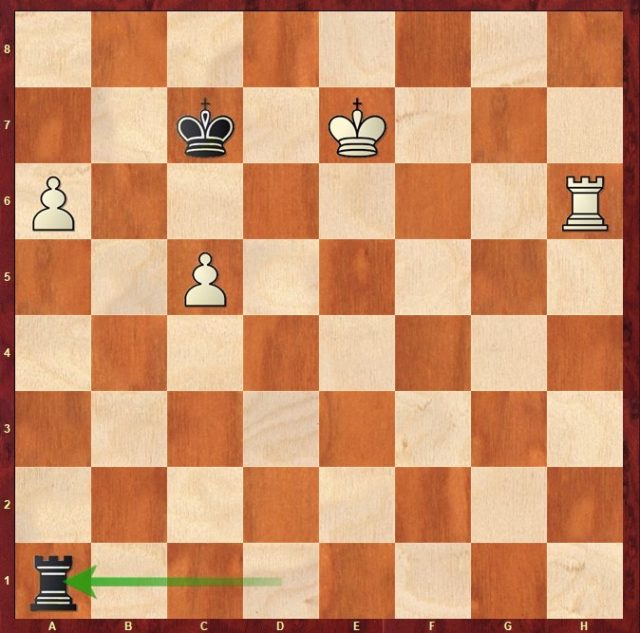
Okay, it’s a draw with the a and c pawns. Everyone knows that, but defending it in practice with only the 10-second increment is another story!
Instead of 68.Rf6, which allows me to draw by force with 68…Ra5 winning one of the two pawns, Magnus could have tried 68.Rd6. At first, I missed that if 68…Ra5 there’s now 69.a7! which wins because 70.Rd8 is unstoppable, and if 69…Rxa7 70.Rd7+. But then I realized when he was thinking (it still took him a minute to play 68.Rf6) that I had the resource 68…Re1+. But after 69.Re6, it would still have been necessary to avoid 69…Ra1? 70.Ke8! and White wins because he vacates the e7 square for the Rook and thus threatens 71.a7. Therefore, the only move would have been 69…Rd1! anticipating 70.a7 Kb7 or 70.Ke8 Rd8+. It was still very, very much borderline!

Mvl-Rapport, Round 5 : 1-0
At first, I thought this French Winawer was going rather well, but I was inaccurate in my piece positioning. I have to say that after 1.e4 e6 2.d4 d5 3.Nc3 Bb4 4.e5 c5 5.a3 Bxc3+ 6.bxc3 Ne7 7.Qg4 Qc7 8.Bd3, I couldn’t remember the sub-variation 8…Qa5!? 9.Bd2 c4 at all. It’s pretty clever, you get positions that Richard likes, of a kind I’ve had against him before and where it hasn’t always gone well for me.
A few days later, Magnus showed against the same opponent what to do: 10.Be2 Rg8 11.a4 Nbc6, as I played is correct, but now 12.Qh3! h6 13.Bh5 Bd7 14.Ne2. I played a bit automatically 12.Nf3 Bd7 13.0-0 h6 14.Rfb1 and thought I was going to be slightly better, but I quickly realized that this wouldn’t be the case because black is very quick to play …f6 or …g5.
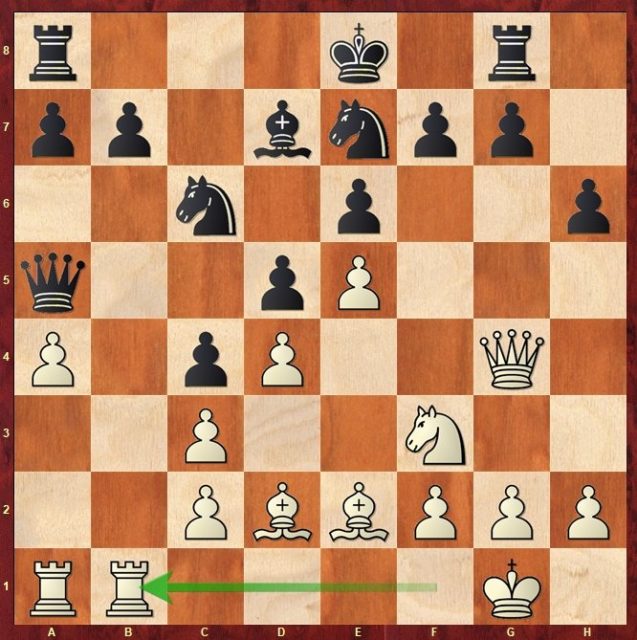
That’s why, after 14…0-0-0, I opted for 15.Rb5 Qc7 16.Qf4 and, with the Queen on c7, 16…f6 17.exf6 would allow a Queen’s exchange favorable to me. And if 16…Rdf8 17.h4! I could control what happens on the Kingside. Moreover, in this position, I threaten the Bc1-a3 thematic maneuver at any time.
Except that Richard chose another path by sacrificing a pawn with 16…g5! which I had seen, but perhaps underestimated. Admittedly, he can’t trap my Queen after 17.Qxf7 Ng6 18.Qh7. 17…Rdf8 didn’t seem problematic either after 18.Qh5 g4 19.Nh4 Be8 20.Qxh6 Rh8 as I was considering giving the piece away after 21.Qxe6+ Bd7 22.Qd6 with no doubt a nice compensation. But in fact he simply played 17…Nf5 18.g4 Rdf8 (if 18…Ng7 19.Qf6, my Queen will always come out) 19.Qh5 Be8 20.Qh3. I thought the worst was over, that I was a pawn up and that my position was still pretty solid. The computer is not at all impressed and even prefers black after 20…Qg7, a rather lunar move, with the idea of bringing the Nf5 back to g6 via e7.
Richard played the more human 20…h5, a move for long-term compensation, which I had expected. Thinking I was better off than I actually was, I wanted to solidify my position when I should have been trying to get something going on the Queenside. After a lot of maneuvering, including my hasty transfer of the King to the Queenside, we ended up in the following position:
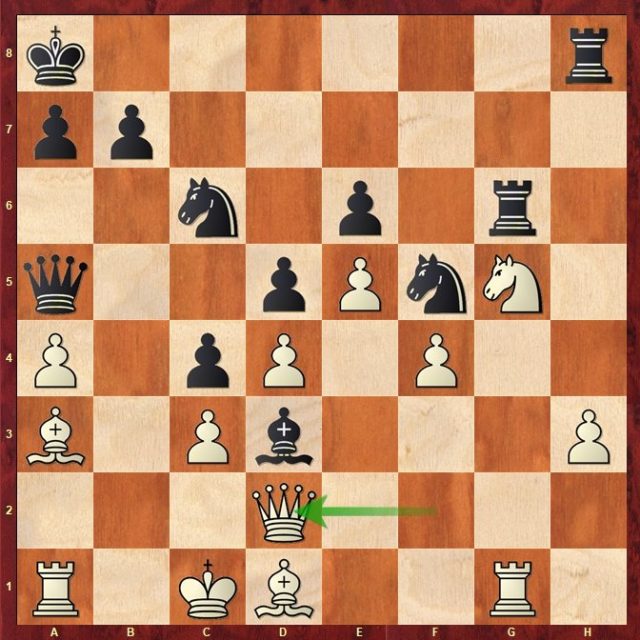
I thought for a long time before playing 38.Qd2 and set a nice trap, since here 38…Ne3 is very tempting, but loses! 39.Bb4! Nxb4 40.cxb4 Qb6 41.Qxe3 Qxb4 42.Bc2 Qc3 43.Ra2 +-. But 38…b5! came as a bit of a blow. After 39.axb5 I wasn’t afraid of 39…Qxb5 40.Qb2, but I realized that 39…Rb8 was strong (40.bxc6? Qxa3+!); it has to be said, Richard is always quite creative in these murky positions! However, after a few minutes’ thought, I came up with 40.Bb2 Qxb5 41.Ba4 Qb7 (or 41…Qb6, I wasn’t sure) 42.Kd1! (my King goes the other way!). The idea was 42…Na5 43.Ba3 and I seemed to be doing pretty well; 43…Nb3 44.Bxb3 Qxb3+ 45.Ke1 followed by 46.Kf2 and everything seemed under control. After 43…Qa6! which is actually the best move, I was thinking of playing 44.Bc5, because if 44…Nb3? I have 45.Bc6+!, but the machine indicates 44…Rg7! which again threatens 45…Nb3 since a7 is now protected; it also threatens 45…Rgb7 and in any case, white’s position looks extremely perilous.
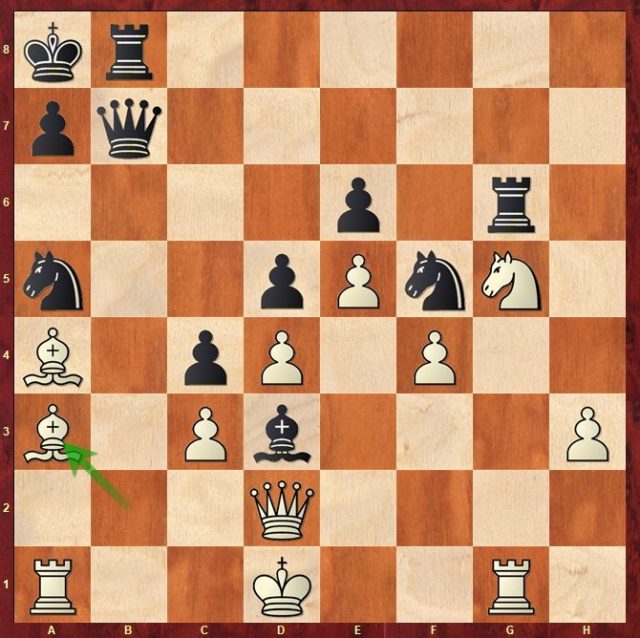
Phew, he played the spectacular but erroneous 43…Qh7?, which still gave me a shock for about ten seconds! Indeed, my King can no longer take refuge on the Kingside, but there’s an antidote! 44.Bb4! and I’ll be able to take the King back to the queenside again; what a royal zigzag! After 44…Qh5+ 45.Kc1 Rxb4 (forced, black’s Queen is now too far from her own King, and if 45…Nb7? 46.Bd1 or 46.Bc6 followed by 47.Qa2 is terminal) 46.cxb4 Nxd4, I had calculated a completely crazy variation! 47.bxa5 Ne2+ 48.Kb2 c3+ 49.Qxc3 Nxc3 50.Kxc3 Bf5? 51.Rab1! Bxb1 52.Rxb1, black has no check, I threaten mate, and if 52…a6 53.Bc6+ Ka7 54.Rb7+ Ka8 55.Rh7+; but I thought it wouldn’t work and indeed there’s 50…Rxg5! or even 50…Qe2. So I preferred to play 47.Kb2 and in case of 47…Ne2, look at the alternatives to taking on a5 (spoiler, there are quite a few!).
But in the end, Richard played 47…Nab3. I wasn’t extremely precise because 48.Qf2! was lethal, and not my choice of 48.Bxb3? Nxb3 49.Qf2, which allowed 49…Nxa1 and black still resists (whereas after 48.Qf2! Nxa1 49.Qxd4, black would have been a full Rook down). I still managed to win a Rook ending in which I was able to remain precise. It gave the tournament a bit of a boost, because before that game, Richard was alone in the lead with a one-point advantage…
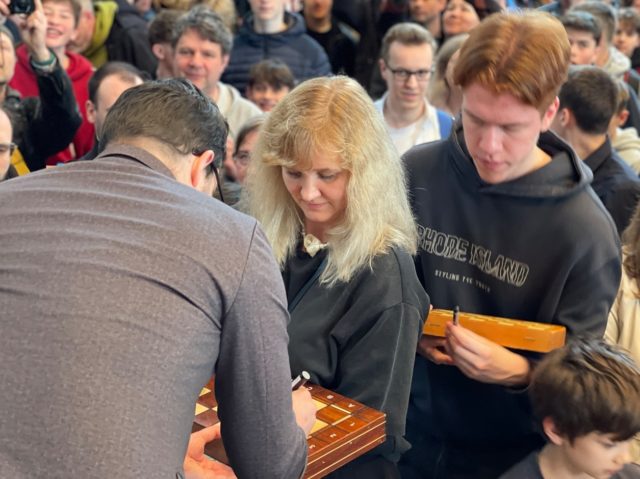
Rapport-Mvl, Round 9 : 1/2
Before this penultimate round, the tournament situation was quite simple: Richard was second behind Carlsen, with a one-point lead over me. So, in order to steal this place from him and play the final match against Magnus, it was almost imperative that I should win with black in this game.
Well aware of the situation, Richard played an extremely solid variation against the Ragozin. I still managed to find a line that kept pieces around and some play in the position:
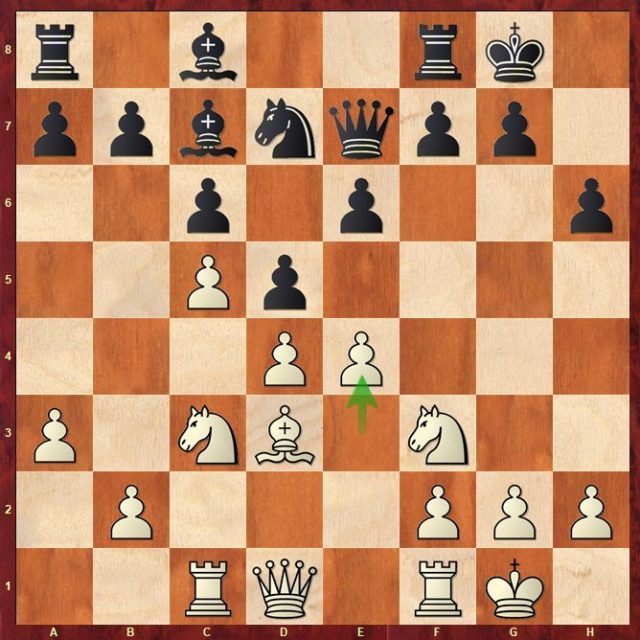
After 13…dxe4, I have to say that he relieved me by preferring 14.Bxe4 to 14.Nxe4; I wasn’t sure what to do because the Knight will land on d6 no matter what, e.g. 14…f5 15.Nd6! Bxd6 16.cxd6 Qxd6 17.Re1 with a nice compensation. And if 14…e5, I was thinking 15.Re1 (there may also be 15.d5 cxd5 16.Nc3, but that’s not certain) 15…exd4 16.Nd6. 14.Fxe4 thus gave me hope of obtaining a more or less playable position. After 14…e5, Richard took a very long time for 15.Re1, because he was checking 15…f5? 16.Bc2 e4 17.Nxe4! fxe4 18.Rxe4, which I had automatically eliminated! As well as wasting time, he didn’t anticipate my a tempo reply 15…Qd8, and that’s when he started to get a bit scared, I think.
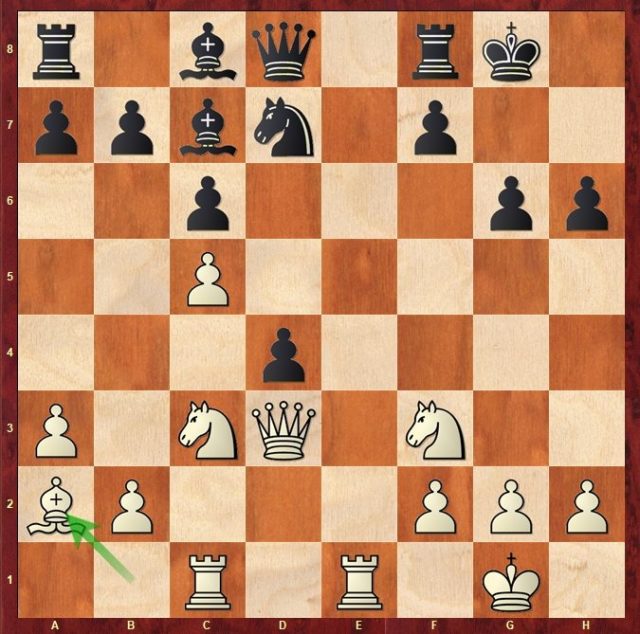
Here, I completely missed the possibility of 18…Bf4!, allowing the scary looking 19.Qxg6+, which would lose the exchange though after 19…Kh8 ; still, this position looks totally unclear to me. Originally, I wanted to go for 18…Kg7, but after 19.Qxd4+ Ne5, I would have allowed the possibility of 20.Nd5! and thought it was never going to work for black. That’s why I finally chose 18…Kh7. I also knew I was wasting precious time, but fortunately Richard didn’t use it so well.
He sacrificed a pawn, which didn’t seem absolutely necessary, and a few moves later, I had a position in which I felt I had winning chances.
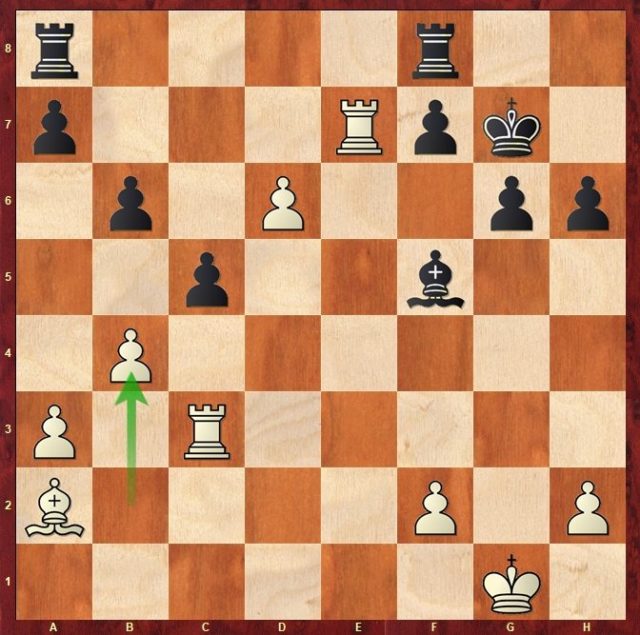
Here, I played 30…Rad8?!, but it proved insufficient after 31.bxc5 bxc5 32.Rxc5 Rxd6 33.Rcc7 and white was able to save the half-point. At first, however, I wanted to take on b4, but it didn’t seem enough at the time: 30…cxb4 31.axb4 Rad8 32.Rc6 Rd7 33.Rxd7 (33.Rc7! immediately is actually much more tenacious) 33…Rxd7 34.Rc7 Rd8 35.Rxa7 and here I missed 35…Be8! winning the d6-pawn and probably the game.
I waited quietly to find out the identity of my opponent for the next day’s final-place match. In the end, it was Keymer who emerged from a three-way tie-break with Ding Liren and Fridman.

All in all, black were pretty strong in this final match, as they got an advantage in three of the four games!
Keymer-Mvl, match for 3rd place, Tie-beak (4): 0-1
After three draws, this match was decided in the fourth game. Thanks to 1.d4 Nf6 2.Nf3 g6 3.Nbd2 d5 4.e3 a5!?, I was able to prevent him from playing 5.b4, more or less circumventing his preparation. It was also a position that seemed quite playable for black.
After a few twists and turns and an inaccuracy on my part, I could easily have found myself in trouble…
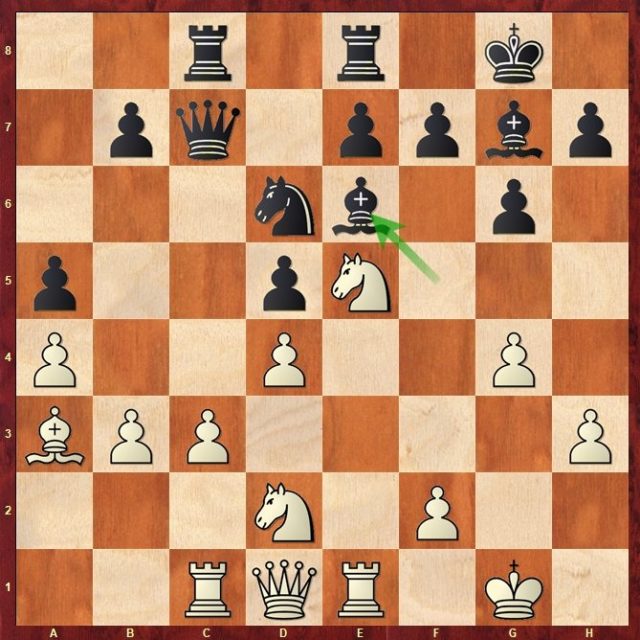
Fortunately, Vincent had already spent a lot of time, and here he missed the strong 20.c4! which would have put my center under great pressure. Instead, another neutral move like 20.Qe2 or 20.Nd3 would have been possible, but not 20.Qf3? which allows 20…Bh6! 21.Rc2? (21.Dd3 was a much lesser evil) 21…Ne4! 22.Nxe4 dxe4 23.Rxe4 Bxb3 and black has a clear advantage. Rather than allowing 24.Rb2 Bd5, Vincent went all in with 24.g5 Bxg5 25.c4, which may look attractive, but doesn’t work. I had calculated 24.c4 immediately, and after 24…Bxc2 25.Qxf7+ Rh8 27.d5, the most accurate was 27…Qb6 which prevents 28.Bb2 and there’s no attack (but of course not 27…Bxe4?? 28.Bb2! and it’s mate). In the game, after 25…Bxc2 26.Qxf7+ Kh8, he played 27.Rg4 Rf8 28.d5 Bf6 but resigned soon afterwards.
Congratulations to Magnus on another victory, after an incredible final match against Rapport!
Maxime’s games in Austria:
Maxime’s games at Grenke :
One of France’s most popular TV programs, « Envoyé Spécial » will devote a long report on Thursday evening (April 11) to the chess boom of recent years. Broadcast on France 2, it will look at the phenomenon from two angles. The first is that of a family of chess players, whose day-to-day life we follow; the second is that of a champion, in this case Maxime, whom the France 2 teams accompanied to training, to a visit to the French Youth Championship in Agen, and to a tournament on the professional circuit in Bucharest.
https://www.france.tv/france-2/envoye-special
